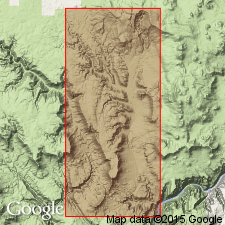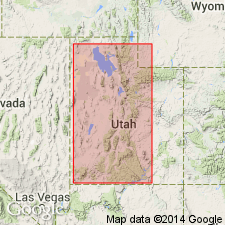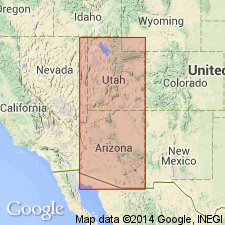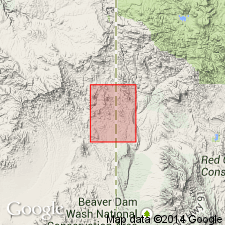
- Usage in publication:
-
- Fossil Mountain Member
- Modifications:
-
- Original reference
- AAPG geologic province:
-
- Plateau sedimentary province
Summary:
Pg. 702. Fossil Mountain Member of Kaibab Formation. Composed of uniformly cherty limestone. Represents maximum extension of Kaibab sea. Lower member of formation; underlies Harrisburg Member. Overlies
Woods Ranch Member (new) of Toroweap Formation. Age is Early Permian (Leonardian).
Study area: Whitmore area, Mohave Co., northwestern AZ.
Source: US geologic names lexicon (USGS Bull. 1350, p. 269).

- Usage in publication:
-
- Fossil Mountain Formation
- Modifications:
-
- Revised
- AAPG geologic province:
-
- Paradox basin
Summary:
Dolomite unconformably above the White Rim Sandstone in UT in the Capitol Reef area and unconformably above the Cedar Mesa Sandstone in the San Rafael area formerly assigned to the Kaibab Limestone is removed from the Kaibab and reassigned to the newly named Black Box Dolomite. Term Kaibab is restricted geographically to two areas of southwest UT discussed in this report --Marysvale and Beaver Dam. Kaibab considered at Marysvale --to be of group rank in this report and is divided into: 1) Toroweap Formation (basal unit) and Fossil Mountain Limestone (top); and 2) in the Beaver Dam Mountains --Seligman (base) and Brady Canyon Limestones, Woods Ranch Formation, Kaibab Limestone ["when a unit is divided into two or more of the same rank as the original, the original name should not be used for any of the divisions." NASC, 1983, art. 19g.], and Plympton Formation (top). Black Box shown as equivalent to Kaibab of the Beaver Dam Mountains. Cross section. Permian age. [Intent or reason to modify rank of Kaibab not stated.]
Source: GNU records (USGS DDS-6; Denver GNULEX).

- Usage in publication:
-
- Fossil Mountain Member*
- Modifications:
-
- Principal reference
- Dominant lithology:
-
- Limestone
- Chert
- AAPG geologic province:
-
- Basin-and-Range province
- Plateau sedimentary province
Summary:
Named as basal member of Kaibab Formation (redescribed). Previously designated beta member of Kaibab by McKee (1938). Named by Sorauf (1962) in an unpublished thesis. Used in publications since 1969. Section 211 ft thick measured by McKee at Fossil Mountain, Coconino Co, AZ, Plateau sedimentary province, designated the type locality. Is a cliff- and slope-former. Consists predominantly of fossiliferous limestone (178 ft of the total section) that varies from yellow to gray, thin-bedded to massive, ledge-, slope-, to cliff-forming, and of white chert beds and one yellow, calcareous sandstone bed at type. Reference section designated extends from southwest corner sec 12, T33N, R9W to top of Hurricane Cliffs, Mohave Co, Basin-and-Range province, where member overlies Woods Ranch Member (named) of Toroweap Formation and underlies Harrisburg Member (revised) of Kaibab. Consists predominantly of cliff-forming limestone that varies from tan, brown to gray, very fine, fine to medium grained, porous to dense. Individual beds may be cherty, silty. Chert also scattered as stringers, nodules, bands, lenses, and irregular masses. Surface weathers rough and gray. Ranges from 178 to 240 ft thick. East limit is a north-south line from Page to Verde Valley. East of that line the Kaibab is not divided. Nomenclature chart. Of Early Permian, Leonardian, age.
Source: GNU records (USGS DDS-6; Denver GNULEX).

- Usage in publication:
-
- Fossil Mountain Member*
- Modifications:
-
- Areal extent
- AAPG geologic province:
-
- Great Basin province
Summary:
Mapped in east-central Lincoln Co., NV in the Great Basin province as the lower member of Kaibab Formation where it overlies Woods Ranch Member of Toroweap and underlies Harrisburg Member of Kaibab. Consists of 80-100 m of gray massive cliff-forming cherty limestone. Chert is nodular, bedded, dark gray to dark-brown, and increases in abundance upward, comprising almost 50 percent of rock near top of Member. Abundant fossils -brachiopods, crinoids, bryozoans, sponges. Of Early Permian, Leonardian age.
Source: GNU records (USGS DDS-6; Denver GNULEX).
For more information, please contact Nancy Stamm, Geologic Names Committee Secretary.
Asterisk (*) indicates published by U.S. Geological Survey authors.
"No current usage" (†) implies that a name has been abandoned or has fallen into disuse. Former usage and, if known, replacement name given in parentheses ( ).
Slash (/) indicates name conflicts with nomenclatural guidelines (CSN, 1933; ACSN, 1961, 1970; NACSN, 1983, 2005, 2021). May be explained within brackets ([ ]).

